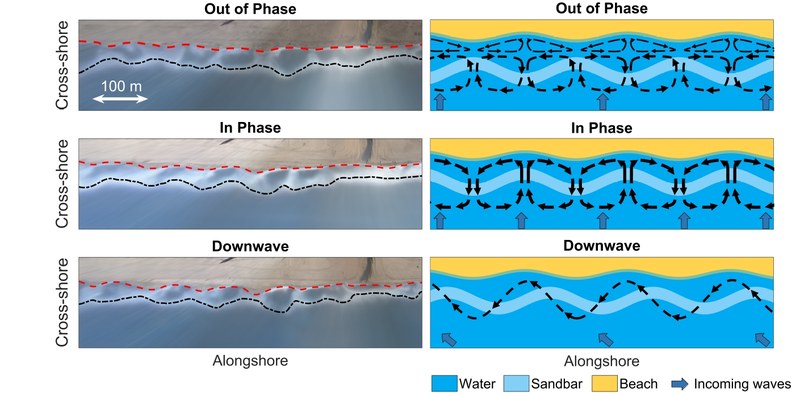Rinse de Swart defends his thesis on beach dynamics
Jul 19, 2022
Rinse de Swart defended his thesis, co-directed by Francesca Ribas Prats and Daniel Calvete Manrique, on July 19, 2022 at the North Campus. Titled "Development and interactions of surfzone morphological patterns", the thesis presents an analysis of the development of sand bars and the coastline, as well as their interactions, on the beach of Castelldefels using 8 years of observational data.
A variety of morphodynamic patterns are typically present in the nearshore zone of sandy beaches that develop due to the interactions between waves, currents and the morphology. The most common are one or several nearshore sandbars that vary in configuration from shore-parallel to crescentic, the latter consisting of alongshore-rhythmic (i.e., undulating) bars (also called rip-channel systems). Crescentic bars are often coupled to similar undulations in the shoreline called megacusps. Understanding the evolution of nearshore sandbars and their coupling to the shoreline is important as they significantly affect the nearshore morphology and hydrodynamics. Alongshore sandbar variability has been studied extensively, but mostly at beaches with substantial tidal range and medium-high energetic waves. Furthermore, the dynamics of megacusps and their coupling with crescentic bars are much less understood.
This thesis uses nearly 8 years of hourly time-exposure video images to study the development and interactions of crescentic bars and megacusps at the open, low-energetic, tideless beach of Castelldefels (northwestern Mediterranean Sea, Spain). This requires accurate directional wave conditions at shallow water which can be obtained in various ways. Here, the accuracy of two available large-scale wave models and propagating measured wave conditions (integrated wave parameters and 2D frequency-direction spectra) using wave ray theory or the SWAN wave model was assessed. Comparing the results of the different methods to a short-term dataset of in-situ measurements showed that propagating measured 2D frequency-direction spectra using SWAN yielded the most accurate predictions for all wave parameters. The other methods resulted in increased errors in wave direction, particularly for shore-oblique and bimodal wave climates due to underestimation of refraction.
The video images together with the hourly wave conditions at shallow water in front of Castelldefels beach (obtained with the optimal propagation method) were subsequently used to investigate the dynamics of crescentic bars and megacusps as well as the corresponding coupling. Crescentic bars were present during 48% of the study period, but only when the bar-shoreline distance exceeded 10 m. They showed a wide range in wavelengths (100–700 m), alongshore migration speeds (0–50 m/day) and cross-shore amplitudes (5–20 m). Low-medium energetic waves with limited obliquity (θ ≤ 20° at 10-m depth) dominated during crescentic bar formation, whereas medium-high energetic waves with strong obliquity (θ ≥ 15°) prevailed during their straightening. These observed angle ranges contradict the results of existing models. Megacusps were present during 24% of the study period and crescentic bars were present during 91% of all days with megacusps, whilst megacusps only occurred during 50% of all days with crescentic bars. Megacusp and crescentic bar wavelengths were similar (100-700 m), but the cross-shore amplitudes (3-8 m) and alongshore migration speeds (0-15 m/day) of the former were significantly smaller. Megacusp dynamics were not strongly linked to wave conditions and they mostly developed a few days after the formation of a crescentic bar, confirming that the presence of the latter induces megacusp formation. Significant sandbar-shoreline coupling was observed during 74% of the time when megacusps and crescentic bars occurred simultaneously. The type of coupling pattern was variable and depended on the wave height and angle, as they probably determine the flow pattern over the inner crescentic bar (single or double rip cell circulations versus meandering currents). Overall, this thesis shows that crescentic bar dynamics strongly depend on the wave direction and initial bathymetric configuration, highlights the strong dependence of megacusp development on crescentic bar presence and provides some ideas regarding the underlying coupling mechanisms.

Share: